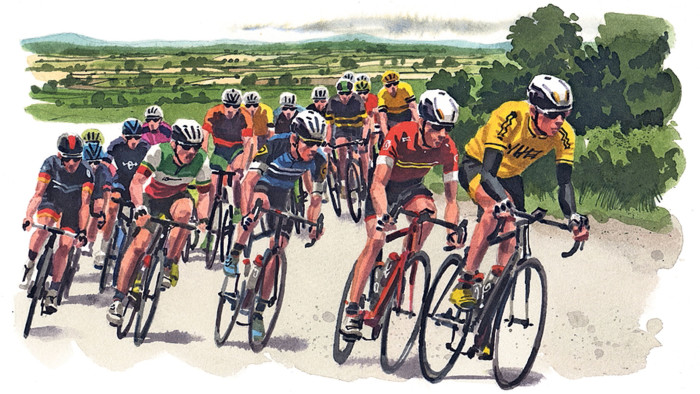Postcard from Carmarthenshire: the Tour of Britain comes to town

Roula Khalaf, Editor of the FT, selects her favourite stories in this weekly newsletter.
The Welsh flags are going up in the Carmarthenshire village of Llanarthne. Next weekend a PA system will appear too and from noon on Sunday, September 2, it will start the first of many renditions of “Titw Tomos Las”, a jaunty Welsh folk song adopted by fans of Geraint Thomas as he rode to victory in last month’s Tour de France.
If all goes to plan, at around 12.10pm Wales’s new hero will arrive into a village throbbing with noise. Alongside him will be fellow Team Sky rider Chris Froome (the first time they’ve raced together in the UK since 2009) plus a panoply of cycling’s elite. The UK’s top bike race, the Tour of Britain, is coming to town and anticipation is building.
“People here watched Geraint in the Tour de France and saw the level of excitement there,” says Simon Wright, owner of café-restaurant Wright’s Food Emporium. “We’re going to recreate that. It’s going to be brilliant.”
Such is the spectacle of 20 professional race teams, including 11 WorldTour teams, pistoning past that nobody I ask complains about their main road being closed. Neither does anyone moan about the recent roadworks. Why would you when surrounding roads are now silky smooth? “The Tour legacy,” Simon jokes. “It feels like people have finally started to recognise how beautiful Carmarthenshire is.”
If Thomas will be the big attraction for many, it’s also a moment to shine for Carmarthenshire, where the race begins for the first time. Indeed, it may be the moment when the county realises its aspiration to become the hub of Welsh cycling.
The Tour starts in the UK’s newest closed road circuit, Pembrey Country Park, launched this month, then swings by Carmarthen, where one of the world’s oldest velodromes was renovated last year. The peloton will fly past toothy castles in the broad Tywi Valley, skirting the Brecon Beacons National Park before crossing into Powys en route to the finish in Newport, 109 miles from Pembrey.
“I’ve been lucky enough to cycle all over the world and every time I come back here I think it’s the best in Wales,” says Matt Page, a former professional cyclist from Llandovery, who now organises events and writes about the sport. “The roads are the quietest. The scenery is magic. The hills are a test. There’s wilderness. Carmarthenshire’s got everything.”
If outsiders are yet to cotton on, blame the neighbours. Wedged between two big hitters of Welsh tourism, the Brecon Beacons and the beaches of Pembrokeshire, Carmarthenshire is often overlooked. To reveal what we’re missing, Matt is leading me on one of the six new routes he has mapped for visitors, downloadable from the local tourist board’s website. Ours, the 59-mile Tywi Valley loop, starts and ends in Carmarthen and takes in a slice of the Tour of Britain route.
Free of Llandeilo’s traffic, we head out on a single-lane road. It’s fantastic riding, the surface is smooth, the air sweet with fresh-cut grass. Drivers hang back a respectful distance before overtaking. (I say “drivers” — we only encounter four cars over eight miles.) The miles zip past to the satisfying thrum of rubber on tarmac.
We’re en route to the village of Bethlehem, where the Tour’s first King of the Mountains ascent awaits — a mile-long, category-three climb. “Hard work, painful,” says Matt. “Then, looking back, brilliant.”
I’m sure the pros will love it, spectators, too. I heed the advice written on the road in Welsh and English — “Araf, Slow” — and summit barely out of breath into a pre-industrial panorama as pretty as a children’s picture book: a rolling sea of fields shaded by woods, here and there a farm aloft on a swell of grass. If Thomas glances up he’s in for a treat.
After a fantastic swooping descent — wind roaring in my ears, road signs flashing past — then an easy peddle along the A4069, we plunge into market day in Llandovery: farmers in check shirts and green gilets, the patter of a livestock auction echoing over roofs.
Next Sunday these pretty streets will be a blur of multicoloured Lycra as the riders compete in an intermediate sprint. Llandovery will be in festive mood, Allan Stather tells me in his café, Penygawse, with bands playing in the square and the chance for the public to race each other on bikes that are fixed on rollers. “Cycling has been our biggest growth area,” he tells me. “We now get 50 or 60 cyclists a day at weekends.”
Yet it’s when we divert off the Tour’s route back towards Llandeilo that Carmarthenshire reveals its essence.
Across a humpback bridge, through a hamlet called Silo, we grind up a punchy little hill to the tree line. Bare moorland hills rise on one side. On the other, green soft-backed hills jigsaw into sinuous river valleys and oak woods, peeling back to the hazy outline of the Black Mountain.
Although the Tour riders are in for a great ride, here’s a tip they can have for free: Carmarthenshire is more rewarding still on its back roads. Being overlooked has its advantages.
Details
James Stewart was a guest of Discover Carmarthenshire and The Plough, Rhosmaen (ploughrhosmaen.com; doubles from £74). Details of the new cycle routes are available at discovercarmarthenshire.com. For the Tour of Britain route and schedule, see tourofbritain.co.uk
Follow @FTLifeArts on Twitter to find out about our latest stories first. Subscribe to FT Life on YouTube for the latest FT Weekend videos
Comments